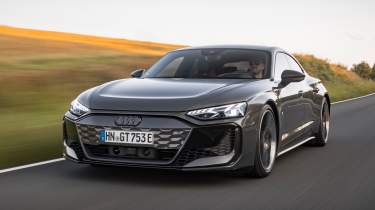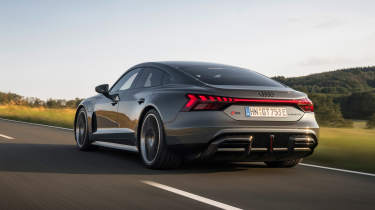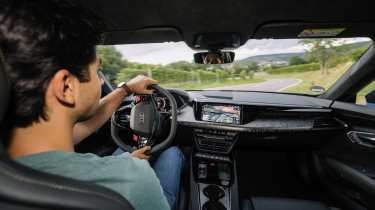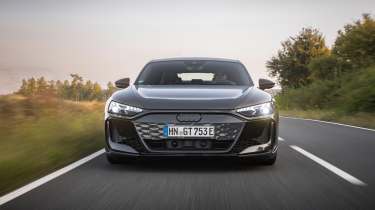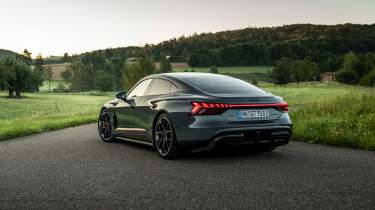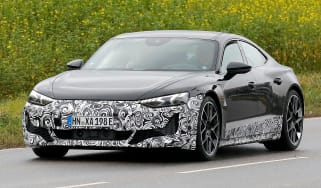Audi e-tron GT 2024 review – more than a Taycan in different clothes?
Audi’s new e-tron GT packs a host of powertrain and chassis upgrades you’ll also find in the latest Taycan. Is it the ultimate electric grand tourer?
It's a dark, chilly evening, the road is wet, and we're riding shotgun with Audi chassis engineer Carsten Jablonowski, who's fiddling with drive modes in the new RS e-tron GT Performance. He finds Dynamic, rolls to a halt and prepares for a launch control start. As he holds the car on the brakes and pushes the throttle, it feels like the combined 912bhp from the electric motors is twisting the driveshafts. After a moment of anticipation, the e-tron snaps forward with almost surreal force, the wine from the motors quivering as the wheels spin and scrabble for grip. They continue to spin beyond 50mph, but somehow the car is still violently accelerating and continues to do so beyond the 62mph benchmark. Then a number pops up on the dash: 2.8 seconds. That’s how long the e-tron took to reach 62mph while struggling for traction on a bumpy, greasy surface.
That’s quite astonishing, but also predictable. We’re used to intergalactic speed from EVs of this calibre, and while the new e-tron GT is on a completely different level of performance compared to its predecessor (the old RS e-tron GT ‘only’ had 636bhp), it also needs to move the game on in other areas. Specifically, in areas that actually matter in the real world, such as the way it drives, electric range and charging speed, because a launch control start is something you’ll do once or twice and probably never again.
The new car might look similar on the surface, but this is about as comprehensive as mid-life updates get. Like the original, it’s based on the same J1 platform as the Porsche Taycan, but improvements to the GT’s battery and powertrain technology have brought the package bang up to date, and in line with the newly-facelifted Taycan.
More reviews
The range is split between three versions – the 671bhp S e-tron GT, the 844bhp RS model and the 912bhp RS Performance – and each get a larger 97kWh battery pack with revised cell chemistry. This results in a 374 mile range for the S (the RS and RS Performance drop to 365 and 364), but despite the increased battery capacity, the new pack is 9kg lighter. At 625kg it still weighs more than an entire Caterham, though…
Charging is faster too, with peak speeds boosted from 270kW to 320 and the ability to hold higher rates for longer periods; a 10-80 per cent top up takes just 18 minutes if you can find a quick enough charger.
Approach the e-tron GT, pull the door handle and the body shoots up on its springs to greet you – a first glimpse at the sophisticated chassis tech Audi has developed for the new car. It’s an active suspension system that comprises air springs and active dampers controlled by hydraulic pumps, which regulate suspension forces at each corner to account for pitch and roll, and can even lean the body in the opposite direction of cornering and acceleration forces. It’s powerful enough that there’s no need for anti-roll bars to manage the e-tron’s 2.3-ton mass, and comes as standard on Vorsprung models (otherwise you get two-chamber air springs with conventional two-valve adaptive dampers).
The suspension and steering hardware (including a new quicker rack and rear-wheel steering) are shared with the latest Taycan, but unique software tuning gives it a different feel and character. The e-tron is a fast, accurate GT car, painless to drive quickly but leaning towards being a calm cruiser, where the Porsche can feel more tense and communicative as you ramp up the driving modes.
With that said, the active suspension means that leaning into the GT role doesn’t come at the expense of control when you need it, and the e-tron’s ability to keep its body flat is quite remarkable. It feels like there’s limitless support no matter how hard you're working the RS Performance’s fat Pirelli P Zeros (265 section at the front, 305 rear), which allows it to turn in and change direction like a much lighter car. It also means the tyres are more evenly loaded and you don’t need to manage weight transfer as you normally would in something so heavy, giving a stronger sense of stability. Useful given how rapidly the RS Performance gains momentum, sucking up the road between corners as if you've fast-forwarded reality.
Of course, you can only use this potential for fleeting moments on the road, and doing so feels borderline uncomfortable. Particularly when it’s time to stop, as the brakes can feel inconsistent; firm when giving them a hard push but strangely springy on light applications. Instead, you find yourself stroking the e-tron along on part throttle, blending in and out of the power to make fast, smooth progress. The Taycan gives a better sense of connection through its steering but the e-tron can still be placed with precision, and the rear axle steering means you can zip through tighter turns in one clean sweep. It’s a satisfying car to drive quickly, but less sports car DNA comes to the surface than in the Taycan.
There’s a unique feel to the way the Audi rides, too. In its softest damper setting the Taycan allows a degree of movement in the body for a slick, slightly floaty ride quality at a cruise, but the e-tron keeps tighter control over long-wave bumps. Jablonowski explained that this is a result of a different philosophy of what a comfortable ride should feel like between the brands, rather than one car being softer or firmer than the other.
Either way, the e-tron GT is compliant, reassuring at speed and great to spend big miles in, particularly in the knowledge that it can go further on a charge than before (although on country roads we managed 254 miles in the RS Performance, some way off Audi’s claim). The active suspension furthers these GT credentials, with an uncanny ability to isolate you from uneven surfaces and keep the body level through big dips and bumps. You don't get the full magic carpet effect at all times – it doesn't iron out high frequency bumps and surface patchwork as convincingly – but the ride comfort is impressive, sometimes strikingly so.
Having said that, the S on standard suspension might just be the sweetest e-tron GT of the lot. For what it loses in freakish body control and primary ride quality it gains in providing a better sense of load going through the car, and you feel more in touch with the road surface. You naturally start using more of its performance and working the chassis harder as a result, and when you do, you’ll find that the e-tron GT can be driven on the throttle in a way that most Audi owners won’t recognise. With the ESP off in the damp it’ll light up its rear tyres instantly under full load, to the extent that you almost treat it like a conventional powerful rear-drive sports car. It will bite if you’re not careful, but be sensitive with the power and the e-tron will dance away from corners, and you can catch and hold bigger slides if you want to.
The S is still phenomenally potent but you aren’t completely overwhelmed by the straight-line performance, and the ride is still cushioned on the standard suspension. It isn’t as serene over bumps, but on 20-inch wheels rather than RS’s 21s there’s a soft edge to impacts, and the e-tron still plays the cruising role very well. The caveat is that we drove the e-tron GT on smooth German roads, and the benefits of the active system may be more obvious on UK tarmac.
Whichever model you choose, the e-tron GT feels like a compelling alternative to the Taycan; it’s not quite as dialled-in to drive but it’s still polished, refined and can be surprisingly entertaining when the moment allows. You could feasibly go for one or the other depending on which you prefer to look at and sit in; the e-tron GT has concept car-like presence but some will favour the Taycan’s simplicity. Both are built to similarly high standards inside, but the Audi is busier and more technical, and you feel like you’re at the wheel of a sports car in the Porsche. Two different characters, then, but both are at the top of the premium EV pile right now.
Price and rivals
The e-tron GT and Taycan might share a lot, but their respective range line-ups are quite different. The S e-tron GT starts at a hefty £108,680, whereas the Taycan can be had in 402bhp single-motor form for £86,500. The Taycan 4S is the closest match for the entry-level e-tron GT, but is still around £13k cheaper with a 134bhp power deficit.
The RS (£127,280) and RS Performance (£143,780) go up against the Taycan Turbo and Turbo S, which pack 872bhp and 939bhp respectively. In truth, only insatiable power junkies should consider these, because lesser models provide a heap of instantly accessible performance and more range for less money.
For a different flavour of fast electric saloon, there’s also the £97,745 BMW i5 M60 and £105,860 Mercedes-AMG EQE 53, both of which trade the Audi’s bespoke look and feel for a conventional luxury saloon character and more cabin space.

